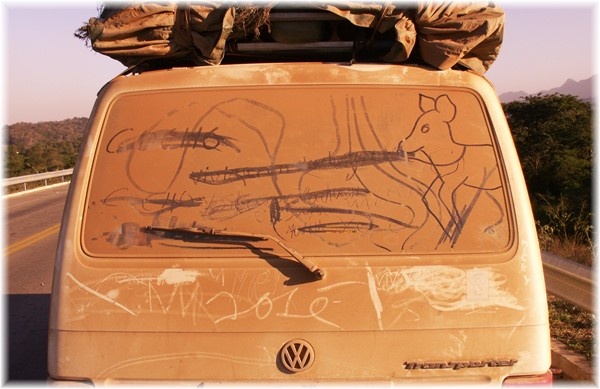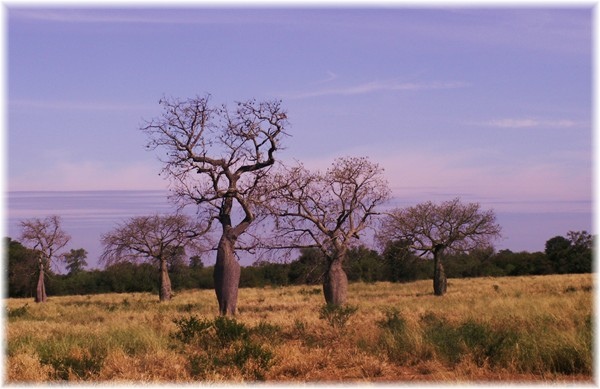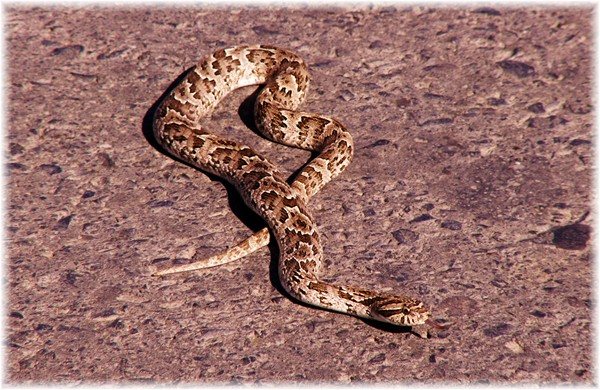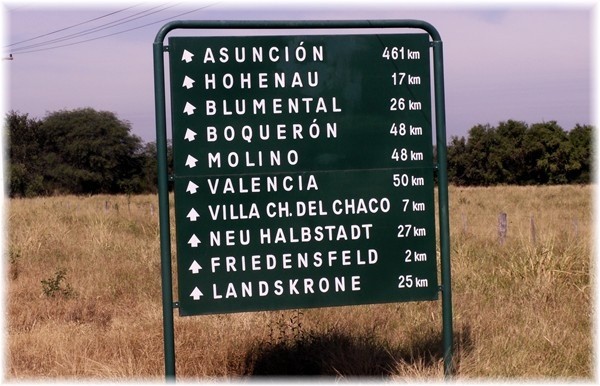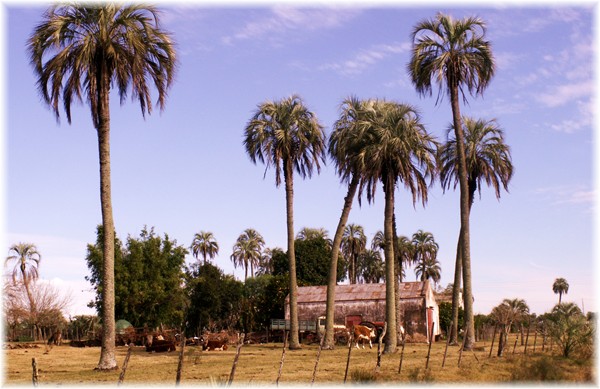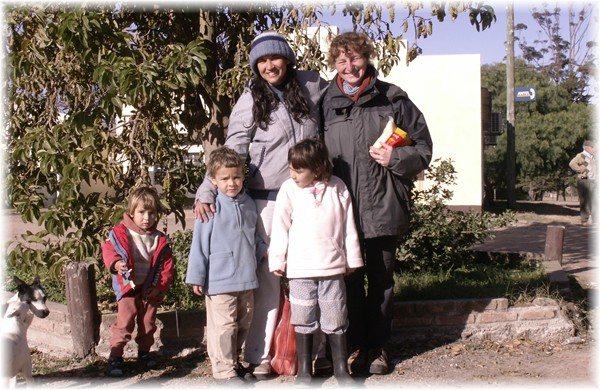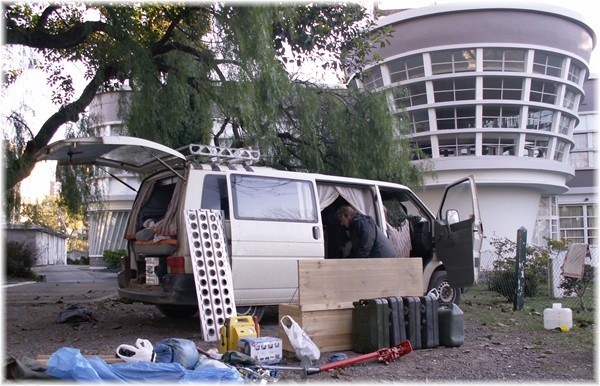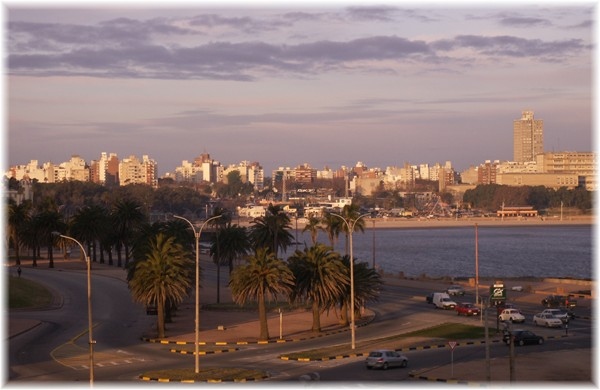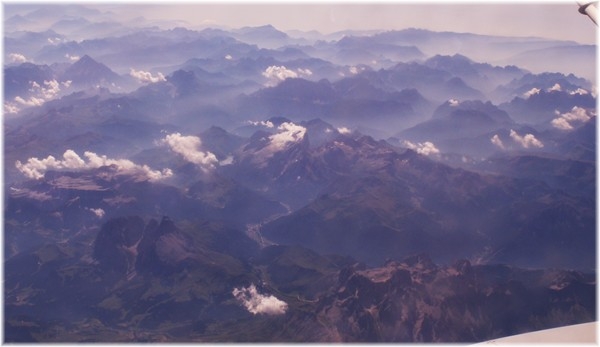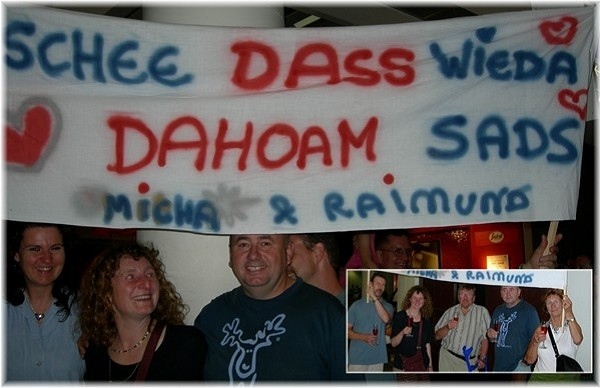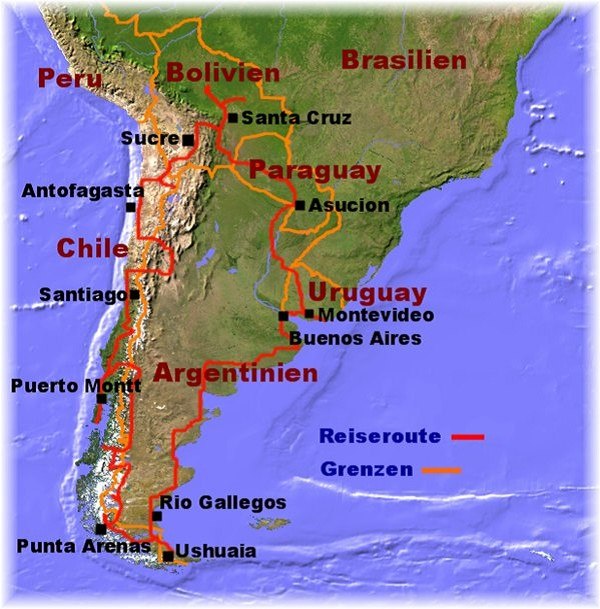After we have left the jungle going southwards direction Paraguay border, the tropical climate cools down again. But the next extreme climate awaits us already. The “Gran Chaco”with its thorn bush savanna and the dry forests. This region starts in the South of Bolivia going over to Paraguay to the northern district of Argentina.
The South-North extension is with it´s over 1500 km long and a surface of 647 500 squarekilometer nearly twice as much as Germany. This region is extremely hot and dry in the Summer. The area is rarely inhabitat and there are nearly no streets leading through. Most of the people which live here are Mennonite settler, working as farmers and as well Indian nomads. We want to cross the Gran Chaco on the socalled Trans-Chaco-Route from west to east. Already in Bolivia we try to get informations about the street, how are the road conditions and which way is the best to drive on. We ask several times and get several different answers. Therefore in the end we drive how our feelings tells us how to do and this is towards Canada Oruro, which is a small bordervillage on the Bolivian side. We are passing a bus with the lisenceplate of Paraguay and know in that moment: we can´t be wrong. If the bus did take the street, we will manage it as well. Before we come to the bordercontroll we have to pass a military area with the usual control. The costums officer on the border of the Bolivian side is very nice and thoughtful. He asks: “Do you have enough drinking water with you?” “Yes” “Do you have enough petrol with you?“ „Yes“ „Do you carry enough food with you along““ Yes even that” “From now on you are alone till Mariscal Escibarribia, about 270 km from here, a stretch which you normally can make under normal circumstances in about 4 hours. But if you loose your way or have a breakdown it can cause you a few days till you get there.” Wow, this are great prospects and really encouraging!!! On top of it he let us know, that in case we would like to change money, we could do that here right away. At the exit of the office his wife is awaiting us and there we change the rest of our Bolivian money which is about 10 Euros into Paraguayanos. Certainly the rating change is very high but what should we do with the rest of our money in a country where it is not valid. Now we have again 40 km to go to the actual border. Again there is a control and since it is getting already dark we ask the Comandante of the paraguayanian side if we may sleep in front of the barracks. No problem, they even offer us the bathroom facilities. Next morning one soldier comes over to our bus and want to see the passports again. As we do so, he tells us that there is no stamp which say that we are tourists. Only the exit stamp of Bolivia. In order to be allowed to enter Paraguay it is a must to have a tourist stamp. We have two possibilities: either we have to go back to Bolivia or we have to pay 10 US Dollars per person. Certainly there is nowhere such a stamp required. We did know about the corruption in Paraguay, we heard about several tricks, but never about this one. Michaela takes back from him our passports and I ask him what his name is and his rank and write it down in our book. I tell him that in case we will have to pay this 10 US Dollars we will do so, but not to him, we will pay it directly at the emigration office. Well and that was the solution for our problem, he disappeared quiet quick. So did we, you never know what comes next. After a few kilometres we see in a distance something black looking a bit like an asphalted street. Well it is not a Fatamorgana, it is a brandnew street made out of Asphalt! On some stretches they are still working to get it fixed but it is nearly finished all the 700 km down to Asuncion. We are sure, that even the very nice officer at the bordercontroll did not know about the new asphalted street.
First of all we have to go now to Mariscal Estigarribia, 230 km from here, which is the most northerly point where people live and as well a military camp of Paraguay. There we have to get stamped our immigration papers. We go further the Trans-Chaco Route. We don´t see a single car passing by the whole long day. Maybe we are really the only one for today. There are many animals in the Gran Chaco, like jaguar, ocelote, tapir, anteaters, but it is seldom to get to see them. Snakes and tarantulas are quiet often to see on this stretch.
Our next destination for today is the mennonite colony. In the year 1927 the first settler of mennonits of German origin did came from Russia to the isolation of the Chaco. In the time of communismn in Russia it was not allowed to belong to a religious community. Here in the Chaco the believers could follow their religion. Mennonits are members of a very strict protestant community which follow the rules in the bible. Nowadays there are three colonies with over 14 000 german speaking people living here. Most of them are only speaking the old low german – Plattdeutsch. The centre of the colonies is a city called Filadelfia. Friends of us have been here 18 years ago and gave us the name of a family living in this colony. We want to visit this family. We drive by farmer houses of the colony and first thing we recognice is how tidy everything is. An old German virtue. It is Saturday afternoon when we arrive and the whole city seems to be deserted. From Saturday midday onwards all shops are closed. No grocery stores are open not even an ATM machine we can spot. After a long time searching and driving through this city we see a group of youngsters and ask them in Spanish about where we could overnight here. But they only speak German and give us the answers in German. Since it is already late afternoon we decide to overnight at the backyard of a hotel and visit just tomorrow the family. It is quite strange to know that we are in the middle of Southamerika and everybody speaks to us only in German, it is like being in a village somewhere in North of Germany. Next morning we hear that the family we wanted to visit is back in Germany, since the father of the family died.
Later on we meet another person of the colony who tells us all about living here in a colony and this is very interesting.
We are going further on the Trans-Chaco-Route. Next to the street there are tent-villages where the Indian families are living. This tents are made out of plastic and rubbish, all what they can find on the streets. Sometimes you can see handcrafts which they are selling. We still have 460 km in front of us till Asuncion, which is the capital of Paraguay and as well the border to Argentina. After we have crossed the border to Argentina it is already dark, Therefore we decide to overnight at a petrol station. In the perolstation there is a minimarcet and we feel like in paradies. What an enourmous variation of groceries and other stuff. In Bolivia and Paraguay we never had such a variety. Now we want to go as quick as we can to Uruguay to visit the different thermal bathes where we want to stay a bit longer, to relax, doing washing as well some reperation on the car. At the town of Salto we cross the border to Uruguay.
Uruguay is a small country, landwise and as well the amount of population. Just 3,4 Millions inhabitants are living here and about half of them live already in the capital of Uruguay – Montevideo. Different then in the rest of South America there are no more native inhabitants. The people here are the descendants of European immigrants. Most of the people are living on agricultur or cattle breeding.
Oh I nearly forgot, I did bring with me a souvenir from Bolivia. Since a few days I really had pain with a corn in my big toe. Michaela look at it and says “ It is already so big, that we should consult a doctor to let it remove, especially to make sure that you don´t get an infection.” I don´t believe that this is a corn and so I take out my leatherman and cut away the skin around. Well what a surprise is awaiting us! A small (approx. 5 mm) maggot is to see. I get it out with a forceps and we clean the hole with iodine. Which beast have been choosing my toe as a nest, we don´t know and maybe that´s even better. The wound is healing quite quick and that’s good.
Our way leads us to the thermal bathes around Paysandu. At the thermal bath of Almiron we nearly stay a week. The warm water is especially good for us since it is icecold since a few days. Here we meet a very kind family: Rainer, from Switzerland who is married to Josi from Brasil with theire three kids. They lived in Brazil but have moved over to Uruguay three years ago. They invite us to visit them in a village named El Ombu near Young, which again is a colony of Mennonits. As well here in this colony in El Ombu, people speak as first language German. Rainer and Josi show us the village and I myself try to ride on Roco, the horse which belongs to Rainer. But I have a bit difficulties in riding, especially because I don´t know how to stop Roco. So I decide I better leave it. We get a sleeping place at the house of grandma “Fast” how they call the widow lovingly. Next day Rainer have to go to a hospital in Argentina for a health examination – a few month ago one of the horses did hurt his knee badly.
It gets around quick that two Germans are in El Ombu. Well we actually have to say, we are nearly a kind of attraktion it is quite seldom that foreigners are passing by. El Ombu is a really nice, charming and quiet village, where you have a bit the feeling that time stands still. You often see old cars which are older then 60 years. A horse is still the most means of transportation – that’s what we found all over South America. In the afternoon we get a tea-time invitation from Armin. This invitation is just the start of many others. Next day Armin invites us again into a restaurant for lunch in the near the town of Young. In the evening we are invited in Elsa and Harry´s house for Pizza , a young family with two girls. Harry did take over the smithy of his father. Today the smithy is more a workshop for agriculturale machines. It is very interesting for us to hear how it have been in 1948 as his parents did come over to Uruguay to settle down here. Some of them are not living anymore but got kids and the kids already have kids again and still it is like in the beginning of the time when they settled down. They speak German, they act German they even think in German. There are more German colonies then just this one and so they even marry German to German. Meanwhile most of them even receive German TV and radio and as well there in one computer with internet connection. Especially since Rainer is living here, he puts up the satellite dishes and he knows all about the internet. Unfortunatly we will not see Rainer any more, since the hospital in which he is, decided to do the operation on his knee right away and we are running out of time.
Yes, this journey is coming to an end, unfortunatly. We would have liked to stay here longer but our travelbudget is running short. Therefore now we have to arrange everything for our return to Europe and once we are there we will think it over what we will, want or can do next.
So first of all we drive to the German embassy in Montevideo to pick up our flight tickets which let send there to.
Originally we wanted to ship our VW Transporter from Montevideo to Hamburg. That would have been the best to do. Unfortunatly the shipping company could not cope with that. We have to have an agent who is arranging everything for us. That means it will cost a lot more. Therefore we decide to go back once more to Argentina – Buenos Aires because there we can do all by ourselfes and we can stay with the bus till he is in the container. It is the same company which we would have taken in Uruguay, but there it is not possible in the way it is in Argentina. All in all it is much more time what we need, especially since after we have arranged everything with the bus we have to go back again to Montevideo where our flights are going out; but it is much cheaper to do it this way. Up we go. Before we cross over by ferry from Colonia to Buenos Aires we stay another two days on an estancia. This was not planned – well what was really planned on our whole trip :-), but tomorrow is a holiday in Argentina and all offices are closed. Because of this holiday we book the ferry in advance, since a lot of Argentinians will take this long weekend for a short trip over to Uruguay and then on Monday back again. We did good, the ferry is nearly sold out when we book it. At 2.00 am we drive to Colonia, the ferry leaves at 4.30 am. First we have to get all papers stamped for the entry to Argentina. This is now the 15th time that we cross borders and this is the easiest one. In just 5 minutes everything is settled. The river “Rio de la Plata” is at this point so wide, that the ferry needs for the crossing 3 hours. With the sunrise we arrive in Buenos Aires. Because of the holiday there is no chance for a room in a hotel. The few campgrounds which are here are closed, it is Winter in South America. On the way through the city we see some military campgrounds and think it over if we should ask there for camping. We venture it, Michaela goes out of the car and asks the soldier who is standing there with his machine gun if it would be possible to camp here for one night. He smiles to us in a bit strange way and shake his head, no way. At least we tried it. (Solution for the strange smile, you will find a bit further down in the report). Michaela has another idea: we will ask at the Yachtclub Olivos, where in a guarded area the motorships are stored. We tell them that we are from Hamburg and belong there to the Yachtclub Hamburg and if by any chance it would be possible to overnight on there ground. The security officer calls for the person in charge and he decides that we are very wellcome. We even have hot showers! Since three weeks now it is really cold, even for Argentinian standarts it is extrem cold. Our heating system is more or less running all the time. In the afternoon we are in the middle of a historical event. Since 1918 it has not snowed, 89 years ago! I can´t really say that we are happy about that and longing from now on even more for the European summer.
Next morning we drive by taxi to the office of Hamburg Süd. The taxi-driver is really nice and try to be our local guide. He points out to the right and left explaining what we see. At that point we are passing the military camp from yesterday he tells us: “Well and this terrain which you see here is one of the most important for us, our president Kirchner lives here with his family”. Well we try not to lough out, now we know, why the soldier did smile to us in this special strange way. As we arrive in the office of Hamburg Süd we get to know, that the custums have new regulations for the tourists. We have to visit a notary, who then signs a paper that our passports are valid. This new rule is since two month and nobody actually know what sence it makes. At the customs office the officer tell us and a lot of other people waiting, that they have a computerbreakdown and Therefore they are not able to work out the papers. We should come again tomorrow, maybe by then the computers are fixed. We and all the others are not happy about that, but there is nothing what we can do about it.
Well now we nearly run out of time, our flights are booked fix. Next day about 1 2/2 earlier as the costums office is opening we are there with new hope. We wait and hope that the officers will open the door with good news. Yes, the computers are working again and so we are really really happy. Every minute counts now. If we don´t manage to get our bus into the container harbour, then we really have a big problem. After already one hour we have all papers with the necessity signatures, no not all, one is missing. The officer tells us that the boss of the custums have to sign the papers as well, but he will arrive just at 2.30 pm. We discuss with the officer and explain that we have an appointment at the harbour, but they do not care. It is our problem. So we call the office of Hamburg Süd and ask for a second appointment. They are so nice to arrange this, but remind us that we have to come es soon as possible, since the workers are going home at 6 pm. Means, if we can´t manage till that time, that our bus is locked in the container, it would be then the next day. At 3 pm we have as well the last signature on our paper and now we have to drive as fast as we can to the container harbour which lies at the edge of the 14 million city directly next to the slums of Buenos Aires. We have to concentrate and look carefully onto our streetmap to make sure not to loose our way and end up in the slums. And certainly we did take the wrong road. But God thanks, a police car stands next to the street and so we stop to ask him the way. He shows us the way and finally we are at the container terminal of Exalgon. There is already Ignazius, a young member of the staff of Exalgon waiting for us and helps us with the costumspapers. Shortly before 6 pm everything is done, the bus is in the container and the costums seals it. Now we have to go back into town to buy a ticket for tomorrow back to Uruguay Montevideo at the ferryterminal. But how we can go back? It is already dark and most of the Taxi drivers of Buenos Aires refuse to drive out here at this time of the day to the harbour of Exalgon since it is next to the slums. Again Ignazius helps us. He organizes a driver of a security company which brings us with his car to a secure part of the town, from where we then can find a taxi. We buy the ferry tickets and go back to our hotel. Tired and knocked out we fall into our beds and sleep to the next morning.
We catch the hydrofoil over to Uruguay and then from Colonia to Montevideo we have to go by bus. Actually we have planned two days for this city, but through the lots of delays we actually just have left one day. On foot we walk through Montevideo but honestly to say, both of us don´t really feel like doing this. Actually we have ended with South America. In the evening we go out for dinner, our last Asado in South America and while we are there we recall the last seven month with all the wonderful people we met.
Punctually for taking off it rains like cats and dogs. With the Brazil airline TAM we fly to Buenos Aires. From there it goes on with the Alitalia to Rome. After 14 hours flying time we land from the South American winter into the European summer. Now we know where the sun has been all the time. It is really hot and we immidiatly take off our pullovers. Two hours flying time to Frankfurt. As we fly over South Tyrolia and we look down to the mountain range, we have to think of Sepp, the 72 year old globetrotter and hiker from Austria whom we met a few times: “I tell you, all over the world I have been climbing mountains but the most beautiful ones are the alps.” How true, the alps are really beautiful…..
The plane lands punctually in Frankfurt. In the entryhall of the airport there are already four people awaiting us. The parents of Michaela, Christian her brother and Lydia his wife are already since 5am on the road to surprise and receive us. At this time we don´t know that. After one hour of waiting were we are still not here, they get nervous. What has happened? Our luggage is somewhere between Montevideo and Frankfurt. Therefore we have to go to the lost baggage counter to inform them. Since we are not the only one without lugguage it takes quite a while. Michaela is switching on her cell phone for the first time after all this month and it still works. There is already a message on it saying: “We wait for you in Hall B 2”. What a surprise, we are wellcomed with champagne, beer and Brezn (typical Bavarian bread) and a sign saying: “.“ SCHEE DASS WIEDA DAHOAM SADS“ (How wonderful to have you back home again). It could´nt be more wonderful. It is overwhelming and Michaela cries a river of tears out of happiness. Again we once more can just say THANK YOU.
Apart from our both families we would like to thank all of you, which have helped us on our journey and certainly for your interest in reading our diary. What we will do from now on, we don´t know till now. Travelling, settling down – we have no idea. We have learned the last two years a lot, which we never would have learnd if we would have stayed back home and go onto our normal life. The main thing we learned: You plan, you have an idea, a vision and life teaches you: live right now, enjoy and live now and here, all the other things are not in your hand.
Money is certainly an aspect which we know, you have to have it in order to realize a plan. Therefore first of all we will work again but what, how and where, we don´t know till now. Before we do that we have to come down in our thoughts, we have to settle our thougts and get ideas what we could and want to do next. But for sure you will here from us soon.
And don´t forget to look into our category „Friends“, here we have some pictures from people/friends we met during the trip in „Northern Europe“ as well than „South America“.
As well don´t forget the Irish proverb
“There are no foreigners, just friends we don´t know till yet.”
Michaela und Raimund
Here the map of our complete route through South America

